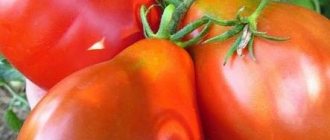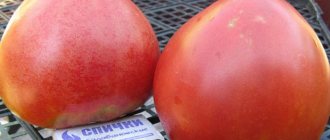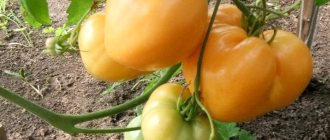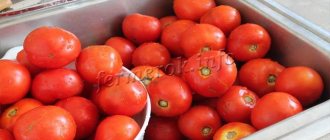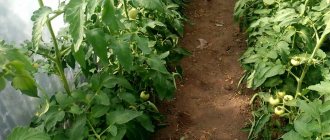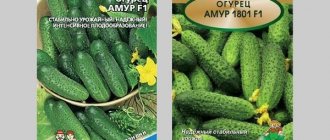- 2.1 Landing
It is no secret that Dutch hybrids of vegetable crops are especially valued by summer residents and gardeners from all over the world. Bell peppers are no exception. For example, a hybrid called Gemini F1 is famous for its high yield, resistance to disease and unpretentiousness to weather conditions. In English, “Gemini” is translated as “twins.” This is most likely due to the appearance of ripe peppers: they are all the same shape, size and color. The Dutch variety is appreciated not only by private gardeners, but also by farmers who grow vegetables on an industrial scale.
Characteristics and descriptions of the Dutch variety, photos and reviews of Gemini F1 pepper can be found in this article. Here we will talk about all the advantages of the hybrid, as well as how it needs to be grown correctly.
Gemini peppers F1: description and characteristics of the variety
The fruits of Gemini pepper are well recognizable - smooth, large, rich yellow in color, with a pleasant taste. Summer residents like the good yield of the variety, large fruit and excellent taste, and those who grow Gemini on an industrial scale appreciate the unpretentiousness of the hybrid and the excellent commercial qualities of ripe pepper.
Photo of Gemini pepper F1
Need to know!
Manufacturers of seeds of this hybrid package seed material in 5-25 pieces in bags, and for large producers there are packages containing from 500 to 1000 seeds of the Gemini variety.
Hybrid Gemini F1 is characterized by early ripening
– from the germination of seed material to the harvesting of ripe products, it takes about 2.5 months.
EXCELLENT VARIETIES OF PEPPERS!
Sweet pepper Claudio F1 Pepper Gogoshary
The bushes are compact in size, they are spreading, the amount of foliage on the shoots is average. The shoots can be up to 0.6 m in height. The foliage is large, wrinkled, dark emerald in color. Due to their size, the leaves protect the ripening fruits from the scorching rays of the sun.
Ripe peppers have a cube-shaped, elongated, drooping shape. No more than 10 fruits are formed on each bush. The thickness of the pepper walls can be up to 8 mm, each fruit has 4 chambers. During the ripening period, the fruits are dark green. Fully ripe peppers are canary-colored. The fruits color slowly.
The most delicious Gemini pepper F1 - video
The length and diameter of ripe peppers are approximately equal - about 17.5 cm. Fruits ripening in a greenhouse are larger than those grown in beds in the garden. The weight of greenhouse fruits is 320-325 g, and those grown in the garden are about 220-225 g.
The skin of the fruit is smooth, its thickness is less than average. The pulp is tender and juicy, and its taste is quite sweet with a slight bitterness, like a real bell pepper.
The variety is resistant to heat; thanks to its wide, large leaves, the fruits are protected from sunlight, do not get burned and do not get baked.
EARLY VARIETIES OF SWEET PEPPER!
15 best early varieties of pepper in open ground
The fruits have a universal purpose:
they are used in the preparation of salads and various appetizers, first and second courses, as well as in canning.
This variety makes delicious lecho. Important!
This variety does not crack during heat treatment and retains most of the vitamins and other useful substances. Therefore, Gemini bell pepper can be canned and used in preparing hot dishes; it will retain its taste even after prolonged heating.
The harvest ripens together, the fruits are approximately the same size and have a good presentation; they are easily separated from the stalks during harvesting.
Ripe fruits
tolerate transportation well over different distances, have good shelf life, their presentation and taste do not deteriorate, so the Gemini hybrid can be grown on an industrial scale.
This hybrid can be planted both in garden beds and in film greenhouses or greenhouses.
This variety tolerates low temperatures well, while its growth and fruit development do not slow down, so Gemini bell pepper can be grown in the Urals or Siberia, where the summer period is short and quite cold.
Features of cultivation
If you follow agricultural techniques that are not considered complicated, the pepper will give a good harvest.
Seed preparation
Since the hybrid is resistant to diseases at the genetic level, they do not need to be treated with additional fungicides, as is necessary when sowing seeds of pepper varieties.
However, it is recommended to treat with growth stimulator Zircon or Epin. They allow you to speed up seed germination, protect seedlings from frost, and increase productivity.
For stratification purposes, Gemini Pepper seeds are placed in the refrigerator, but not in the freezer. Every day, the seeds are kept in the cold for 30 minutes at first, gradually increasing the time to several hours. After each procedure, the seed material is left in a warm room.
At the end, you can germinate the seeds to increase germination to 100%. To do this, they are soaked in damp gauze for several days until the shell bursts.
Seedling soil
The soil for seedlings must be saturated with various organic components. You can make your own soil mixture; it must meet the following criteria:
- Air- and water-permeable.
- Loose.
- Nutritious.
- Should not contain heavy metals.
- Treated against pests.
To prepare the soil, you need to mix turf soil, river sand, peat and sawdust from coniferous and fruit trees in equal proportions. The finished mixture must be treated with fungicides or calcined in the oven, heating it to 90-100 ºС.
Important! You should not make the temperature too high, so as not to kill the beneficial substances in the soil.
Before sowing, seedling pots should be washed with a solution of laundry soap and then with a fungicide.
Read in another article: When and how to plant pepper seedlings: planting seeds, timing rules, preparing seeds and soil, care rules
Seeds for seedlings are sown at the end of February - mid-March, depending on the growing region.
The soil is loosened and watered with warm water. Next, make holes 1 cm deep and place the seeds in them. The crops are covered with a small layer of soil, watered with warm water from a spray bottle and covered with transparent material.
After seed germination, the plantings are transferred to a well-lit place and the film is removed. Seedlings should receive at least 12 hours of daylight. When 2 true leaves appear, the seedlings are picked.
Transplantation into the ground
The seedlings are transferred to a permanent place when the soil warms up to 15-17 ºС and the risk of return frosts has passed. Most often, planting is carried out in late May - early June.
Advice! Peppers are planted in an area where legumes, cucumbers, cabbage, herbs or grains previously grew. You should not grow peppers after potatoes, tomatoes, or eggplants.
The area must first be cleared of weeds, loosened and fertilized with organic fertilizers in the fall.
Planting scheme: 60 cm is left between rows, 40 cm between bushes. To plant seedlings, dig holes and add a little humus to them, watering them generously with warm water.
The seedlings are transferred to a permanent place when they grow to 25-30 cm in height. Pepper stems do not form additional roots, so the seedlings are not buried.
The soil around the bushes is mulched with straw or sawdust to retain moisture and prevent weeds from developing.
You might be interested in: Secrets of growing bell peppers in a polycarbonate greenhouse and in open ground from seeds and seedlings
Advantages
The main advantages of Gemini bell pepper include:
- the fruits ripen quickly;
- the entire harvest ripens together and almost simultaneously;
- ripe peppers are large;
- the flesh is tender and the skin is crispy;
- The fruits have a pleasant sweetish taste with a slight bitterness;
- the bushes are quite compact and of medium size, so the Gemini variety of sweet pepper can be grown even in small gardens;
- high productivity;
- bushes of this variety are able to adapt to any weather conditions;
- high resistance to most diseases, as well as to attacks by insect pests and their larvae;
- versatility of purpose of the harvested crop.
It is important to know!
This large-fruited variety is not suitable for stuffing, but is well suited for preparing salads and snacks.
This bell pepper has few main disadvantages:
- The Gemini variety is demanding on the amount of fertilizer applied. If there is a lack of nutrients in the soil, the skin of the fruit becomes too thin and the pulp lacks juiciness;
- The stems of this variety are too thin and often cannot support the weight of ripening fruits and may break. Therefore, despite the small height of the shoots, they should be tied up as the fruits ripen;
- Gemini peppers may have uneven coloring during the period of full biological maturity, which reduces their marketability.
Sweet pepper Gemini F1 - video
Landing
The seeds of the hybrid are prepared for planting (disinfected, stimulated); before sowing, it is enough to soak them and keep them in warm water.
With planned cultivation in heated greenhouses, planting begins in January. For seedlings, peat pots (10 by 10 cm), plastic glasses (0.2 l each), or cassette containers (with a side of at least 10–12 cm) are suitable.
The bushes are cared for according to standard rules:
- water with settled water;
- feed 2 times (Fertika, mullein solution diluted 1:12);
- hardened at 14–16 degrees for 10 days;
- additionally illuminated with phytolights up to a total day length of 14 hours.
It is useful to include potassium salt (1 g), saltpeter and superphosphate (3 g each) in the fertilizer per 1 liter of water. The solution is used to fertilize twice.
At 50–60 days of age, young bushes of the variety are ready for planting in a permanent plot. Their height should be 16–20 cm, the number of leaves should be at least 6.
Planting Gemini pepper for seedlings, open ground and greenhouse
It should be remembered that the Gemini bell pepper is a hybrid, so its seeds collected from mature fruits are not suitable for further planting - the plants grown from them will not have positive parental qualities. Therefore, seed material must be purchased annually in specialized stores.
Photo of planting peppers in open ground
This hybrid is grown by seedlings.
In the southern regions, where seedlings are transplanted into beds earlier than in other regions, Gemini pepper seeds should be sown for seedlings in the second ten days of February. In areas with colder climates, it is necessary to sow seeds for seedlings in early March.
On a note!
Seeds purchased in specialized stores from well-known agricultural companies that produce seed material have already undergone pre-sowing preparation, so at home they can only be germinated in a wet cloth.
Photos of pepper seedlings
The root system of Gemini peppers is delicate, so the plants do not tolerate transplanting and picking.
Experienced vegetable growers recommend immediately planting the seed material of this variety in separate containers (preferably in peat cups). Together with the peat container, the grown seedlings can be planted in a permanent place. In this case, the roots will not be damaged, the plant will acclimatize faster in the new place, and the peat cup, decomposing in the soil, will become an additional fertilizer.
Since these plants love good light and warmth, from the moment of planting the containers should be kept on the windowsill at a temperature of about 23 degrees Celsius. The first shoots appear approximately a couple of weeks after planting.
For normal growth of seedlings, it is necessary that they receive a certain amount of light during the day; 12 hours of daylight is enough for them. If there is not enough lighting, it is necessary to supplement the seedlings by installing phytolamps nearby.
Photo of planting peppers in a greenhouse
During the period of growing Gemini pepper seedlings, it should be fed with nitrogen-containing fertilizers at least twice. The first fertilizing is carried out at the stage of two true leaves, the next application of fertilizers is carried out a couple of weeks after the first, but no later than 10 days before transplanting into open ground or a greenhouse.
10-12 days before transplanting seedlings to the beds, they should be hardened off
. To do this, the plants are taken out into the fresh air for a short time at first - only about 30 minutes, but gradually the time spent on the balcony or loggia is increased.
It is recommended to plant grown healthy seedlings in a permanent place at the age of 1.5 months. Depending on the growing region, the planting time will be different - in the south, Gemini bell peppers are transplanted into open ground in the second ten days of May, and in colder areas - in early June.
We plant pepper seedlings in open ground (greenhouse). Soil composition, watering - video
By this time, the growth of young peppers should be about 16.5 cm, and at least 5 true leaves have grown on each plant. It is acceptable for buds to appear on the seedling bushes.
Important!
Overgrown pepper seedlings can only be transplanted into a heated greenhouse. When planting such seedlings in open ground, they will take a long time to acclimatize.
VEGETABLES:
Aral squash F1 Kolya cabbage F1 Zucchini squash Orange F1
The planting site should be on a slight hill (or on a flat surface) and protected from strong gusts of wind or drafts.
The soils should be sufficiently loose and nutritious, preferably carbonate.
The best predecessors for this vegetable crop are all varieties of cabbage, peas, beans, soybeans, and grains.
It is recommended to plant no more than 3 bell pepper seedlings on each square of area. The planting pattern for seedlings of this variety is 0.5 * 0.4 m.
Photo of pepper planting scheme
The soil temperature when planting seedlings should warm up to +14+16 degrees Celsius.
A nutrient substrate is placed at the bottom of the planting holes, to which organic matter and mineral fertilizers have been added.
After planting, the plants are watered abundantly and mulched with any organic matter.
Growing rules
Growing a Dutch hybrid is not difficult, because it is very unpretentious and resistant to external factors. The gardener must remember the hybrid origin of Gemini: the seeds of this pepper do not retain complete information about the genes - the fruits will mutate, change color, size or shape. Therefore, planting material will have to be purchased annually.
Landing
In the southern regions, Gemini F1 seeds begin to be sown in the second half of February. In colder regions, the vegetable is sown for seedlings a little later - in the first ten days of March. If you need early seedlings for a heated greenhouse or greenhouse, you need to sow peppers already in January.
It is better to sow the seeds in 200 ml plastic cups or in special peat tablets, so that later the seedlings do not have to be planted - pepper does not tolerate this procedure well.
Gemini sweet pepper loves warmth and light. For the first 12-14 days, containers with seeds should be kept at a temperature of 24-27 degrees. During this time, the first shoots will appear, then the pepper seedlings can be removed to a cooler but brighter place.
Important! Usually Gemini is illuminated artificially, because the seedlings will turn out strong and healthy only if they receive twelve hours of lighting.
When the pepper is 40-50 days old, it is planted in a permanent place. Depending on where Gemini will be grown, the recommended planting dates also change: seedlings are transferred to the greenhouse in mid-May, and sweet peppers can be planted in open ground no earlier than the first days of June.
The height of pepper seedlings at the time of transplantation should be 16-17 cm, each bush should already have 5-6 true leaves. The presence of flower ovaries is acceptable. But it is not recommended to overexpose bell pepper seedlings. At 65-70 days of age, Gemini is planted only in heated greenhouses; this is done in mid-spring.
Planting Gemini pepper in a permanent place is carried out according to the following rules:
- Choose a site on level ground or on a slight hill.
- It’s good if there is protection from strong winds and drafts.
- Soils are preferred nutritious, loose, carbonate.
- The best precursors for bell peppers are cabbage, legumes and grains.
- The planting scheme for small volumes is three bushes per square meter.
- Gemini shows the best yield with this scheme - 50x40 cm.
- The soil on the site or in the greenhouse should warm up to at least +15 degrees.
- It is recommended to fill the planting holes with a nutritious soil mixture mixed with organic matter or mineral fertilizers.
- Immediately after planting, pepper seedlings are watered and the soil around the root collar is mulched. Mulch will protect the roots from overheating and hypothermia and help retain moisture.
Advice! In the northern and central regions of Russia, it is recommended to cover Gemini seedlings with film for the first time. Gradually the shelter is removed, monitoring the weather and the condition of the plants.
Care
The yield of Gemini pepper declared by the originator of the variety can vary greatly in practice. This indicator largely depends on the nutritional value of the soil, the quantity and quality of fertilizing. Bell peppers will not grow on their own; this crop needs care.
Here's how to care for Gemini F1:
- Cover the soil with mulch or constantly loosen it, remove weeds, and monitor moisture.
- Use a drip irrigation system or water the bushes by hand, avoiding cracking the soil and exposing the roots.
- Pick off the first “royal” buds.
- Form pepper seedlings into one or two stems, removing excess shoots.
- In greenhouses, it is better to cut off the central ovaries to prevent the fruits from becoming smaller.
- Tie up the bushes when the fruit begins to swell and increase in size.
- If necessary, normalize the number of fruits, leaving no more than ten pieces on each plant.
- It is imperative to feed Gemini peppers. In the fall, the soil is filled with organic matter, and in the summer this hybrid is fed only with mineral fertilizers. There should be at least three feedings: the first time a week after planting, the second - in the flowering phase, the third feeding is carried out when the fruits begin to change color.
Attention! Gemini pepper does not like excess fertilizer: it is better to feed it often, but little by little. The culture especially needs elements such as potassium, calcium, phosphorus, boron and magnesium.
Further care for the Gemini pepper variety
Further care for this bell pepper consists of regular watering (it is better to use drip irrigation), loosening the soil after watering, removing weeds, and adding a layer of mulch.
When watering, you need to monitor the soil moisture, preventing it from becoming waterlogged. The first buds on the plants are removed.
Photo of watering peppers
Gemini peppers into two stems to maximize the yield of the bushes.
The bushes require garter as the fruits ripen.
It is recommended to leave no more than 10 fruits on each bush, removing excess ones, otherwise the peppers may become smaller, since there are not enough nutrients for a large number of ovaries.
How to feed peppers
The beds for bell peppers are prepared in advance, and in the fall, up to 6 kg of humus or compost are added to each square of area for digging.
During the summer, Dzhemeni peppers are fed three times with mineral fertilizers containing phosphorus and potassium:
- the first feeding is carried out 12-14 days after transplanting the seedlings to a permanent place of growth;
- the second time fertilizer is applied during the flowering period;
- The last fertilizing is done when the fruits begin to turn yellow.
Important!
When applying fertilizers, you need to observe the measure, since this variety does not like an excess of nutrients. These peppers require the following minerals: potassium, calcium, phosphorus, magnesium, boron.
Parasites and diseases
According to the description, this variety of peppers has a high immune system, so it is not affected by either viral or fungal diseases. This characteristic of the variety has a good effect on the final yield, because no extraneous factors interfere with the development of the plant.
Prevention of diseases and parasites cannot be neglected. Prevention solutions are easy to prepare yourself at home. Often solutions of manganese, wood ash or tobacco dust are used for these purposes. As a preventative measure, bushes are sprayed once every 2 weeks.
Reviews of Gemini pepper
Irina, 45 years old, Vladimir region: Although the Gemini bell pepper fully corresponds to the positive characteristics given in its description, I would now like to talk about its shortcomings. Seed packets are quite expensive. Although all the seeds sprouted. I planted it immediately in open ground, but the shoots appeared only after I started watering with nitrogen-containing fertilizers. Only 6-8 ovaries formed on each bush. Although the fruits were large, I did not get the expected yield. Moreover, even ripe fruits had uneven skin color. I believe that this variety is more suitable for industrial cultivation.
Natalya, 45 years old, Volgograd region: I planted this variety for the first time three years ago. In principle, I am satisfied with it - the yield is good, the fruits ripen smoothly, they have a pleasant taste. I use these sweet peppers for food, prepare lecho and freeze them for the winter.
Gemini pepper is an excellent compact early-ripening variety with high yield and good taste of the fruit.
It can be grown in garden beds or in a greenhouse in most Russian regions.
Reviews
Summer residents highlight the high germination of seeds, the bright taste and color of the fruit. As a rule, there is no negative attitude towards this variety.
Irina, Taman: “I’ve been growing Gemini f1 for several years with great pleasure. The seeds germinate quickly, and in open ground the plant produces a lot of fruit. I use it fresh for salads; yellow peppers look beautiful in winter preparations.”
Alevtina, Syzran: “I used to be suspicious of hybrid seeds. But I decided to try Gemini pepper f1. I tried to follow all the rules of growing: I fed it, did not allow it to become waterlogged, and did mulching. Imagine my surprise when the bright, beautiful peppers ripened almost simultaneously, all identical and identical. I advise everyone to grow this pepper now.”
Mikhail, Orel: “Farmers know that hybrid seeds are excellent for use when growing vegetables in large quantities for sale. So Gemini pepper f1 showed its best side. Of course, it requires care: fertilizing, regular watering and tying up the bush are necessary. But the result is worth it - the bright yellow, beautiful fruits don’t sit on the counter.”
Description from the manufacturer
Early maturing, extremely productive hybrid. From germination to technical ripeness 85-90 days. The plant is medium-sized, compact, up to 60 cm high, simultaneously producing up to 10 “twin” fruits of impressive size. The fruits have a beautiful elongated cuboid shape, up to 18 cm long, smooth and shiny, weighing 200-250 g, dark green in technical ripeness, bright yellow in biological ripeness. The thickness of the fleshy wall is 5.5 -7 mm. The taste is excellent and the marketability is high. There is good foliage, which protects the fruits from sunburn. Resistant to stressful and unfavorable weather conditions, therefore suitable for growing in regions with cool and short summers. At a temperature of +25+28°C, seeds germinate on the 10th day. Sow only sprouted seeds. Gemini F1 has high immunity to major pepper diseases at all stages of growth, including potato virus. Suitable for canning, home cooking and fresh consumption. Recommended for growing in open ground and film greenhouses. Planting density 3-4 plants/m2. Productivity in open ground is 4.0-5.0 kg/m2, in protected ground – 7.0-9.0 kg/m2.
Advantages and disadvantages
This hybrid has its own advantages, which we will discuss further:
- Early ripening.
- The fruits are large and tasty.
- Excellent keeping quality.
- Resistance to long-term transportation.
- High immunity to pepper diseases.
- Easy to care for.
- Harmonious ripening of fruits.
- Suitable for growing in greenhouses and open ground.
- Universal application.
The disadvantages of a hybrid include the following:
- Uneven coloring.
- The stems are fragile, so they require garters to supports.
- Self-collected seeds are not suitable for further cultivation.
- Seeds from the originator are expensive.
Growing and care
On the plot, the peppers are planted at a distance of 50 cm. The plants are placed in the holes directly in cups, the neck is not deepened. The bushes are watered moderately and regularly. The frequency depends on humidity: within 1–3 times a week. Moisture norm per 1 sq. m - 7–11 l. To keep the beds moist and reduce the frequency of watering, farmers advise spreading mulch in a layer of 7–8 cm.
During the season, plants should be fertilized at least 3-4 times to improve the quality and size of the fruit. At the height of the heat, it is useful to carry out sprinkling or foliar feeding (from whey, yeast, peroxide, onion peels).
The bushes are formed into 2 stems, and excess shoots are pinched below the crown fork. To strengthen the clusters with massive fruits, posts in the beds or trellises in greenhouses are used for fixation.
Care
- Watering is carried out as the top layer of soil dries. Often, after moisture is absorbed, an earthen crust is created that prevents the flow of air to the roots. To prevent its occurrence, the next day after watering it is necessary to loosen the soil.
- The first bud must be removed. In order to increase the size of the fruit, excess ovaries are removed, leaving 5-7 pieces on each plant.
- To get a good harvest, peppers must be fed.
- If the crop is grown indoors, you cannot do without gartering the bushes.

